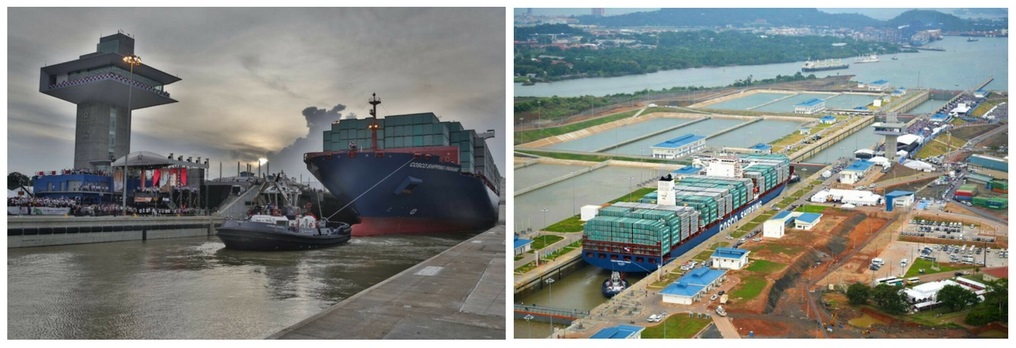The newly expanded Panama Canal officially opened for business on 26 June with the appropriately named MV Cosco Shipping Panama making the inaugural transit through the 80km waterway.

The expansion marks the end of a USD 5.3 billion nine-year construction project aimed at boosting cargo volumes and facilitating greater trade between the Americas and East Asia. The original canal was built by the US government. It took 10 years to build and it was opened in 1914.
The expansion involved building a third set of locks which allows the canal to accommodate vessels of up to 13,000 twenty foot equivalent units (TEUs), up from 4,400 TEUs previously, including the vast 12,000 TEU-plus ‘neo-panamax’ containerships. As much as 79 percent of global cargo-carrying capacity will be able to access the canal, up from 45 percent, saving neo-panamax-class vessels up to 14 days transit time on round trips. The state-owned Panama Canal Authority (ACP) predicts the expansion will generate annual revenues of US$ 2.1 billion.
As of 2nd August, the ACP said 69 neo-panamax ships had passed through the canal, with 40 containerships, 24 LPG tankers, as well as two Liquid Natural Gas and vehicle carriers. The Authority added that so far it has received 250 reservations and counting for the expanded canal, including seven cruise ship reservations.
“We are very pleased with the first month of operations at the expanded canal since the Inauguration,” said Panama Canal Administrator and CEO Jorge L Quijano.
The canal’s extra capacity should, in theory, bring lower rates for shippers. Walter Laffitte from Canal Movers in Panama City is convinced it will be beneficial. “With this expansion the world commerce will benefit with fewer trans-shipments and a direct effect on the economies of scale,” he said. “This will impact us as international movers and our customers with shorter transit times and lower costs.”
However, the scheme is proving controversial with some industry experts predicting that safety concerns could result in insurance premiums wiping out any savings. London-based risk management consultancy PGI Intelligence issued a press release on, 7 July; an extract is below:
Despite the huge advantages offered by the canal’s expansion, there have been growing concerns over safety issues associated with the introduction of neo-panamax vessels along the waterway. Industry bodies have warned that at 427 m long and 55 m wide, the new locks are too small for the neo-panamax. The largest vessels can measure up to 366 m long and 49 m wide, leaving a distance of just 6 m across the width of the canal and 61 m length-wise, much of which will be taken up by tugboats on either end of the vessel to guide it through the lock. A joint study by the International Transport Workers’ Federation (ITF) and Brazil’s Fundação Homem de Mar (FHM) found that under windy conditions the manoeuvrability of vessels would be compromised, making accidents likely due to the lock’s narrow dimensions.
The prospect of an accident involving such large vessels and cargo loads presents significant financial risks for shippers and insurers. An accident would also impose indirect costs as a result of delays to scheduled transits through the canal. Insurance agency Allianz Global Corporate & Specialty released a report in June 2016 which estimated that the expansion will see an additional USD 1.25 bn worth of insured goods pass through the canal in a single day, based on the average value of USD 20,000 per TEUs. The report called on shippers and insurers to take active risk mitigation measures to assess and spread the impact of an accident involving a neo-panamax vessel, as a single event could result in much larger losses than typically seen in the shipping industry.
The full PGI report can be read by visiting www.riskportal.pgitl.com
In a statement at the end of July, CEO Jorge L. Quijano said that to date there has been only one official incident in the new locks, despite reports to the contrary. The incident occurred July 21 when an 8,500 TEU containership belonging to China COSCO Shipping made contact with one of the walls at Agua Clara Locks, causing a gash in the ship’s hull. The incident did not interrupt traffic through the lock or the Canal, and the ACP added that it has not received a claim related to the incident.
As with any major civil engineering project – and they don’t come much bigger than this – there will be teething problems and those who cast doubt on the viability and wisdom of the enterprise. However, dramatically expanding the capacity of one of the world’s most economically important trade routes must surely in the long term be a positive step. No doubt there will be setbacks along the way, but it is likely that future generations will look back on 2016 as a milestone year in the development of international shipping.
Click here to see the next Editor's Pick